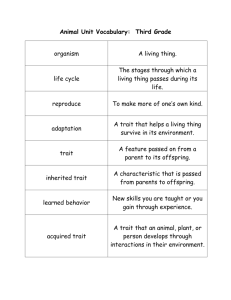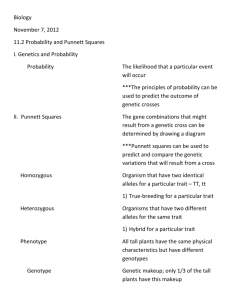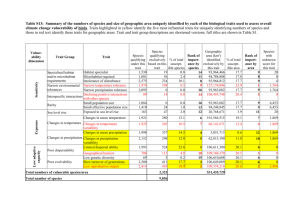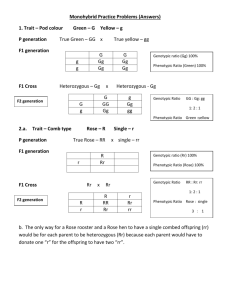ece31212-sup-0001-AppendixS1-S8
advertisement
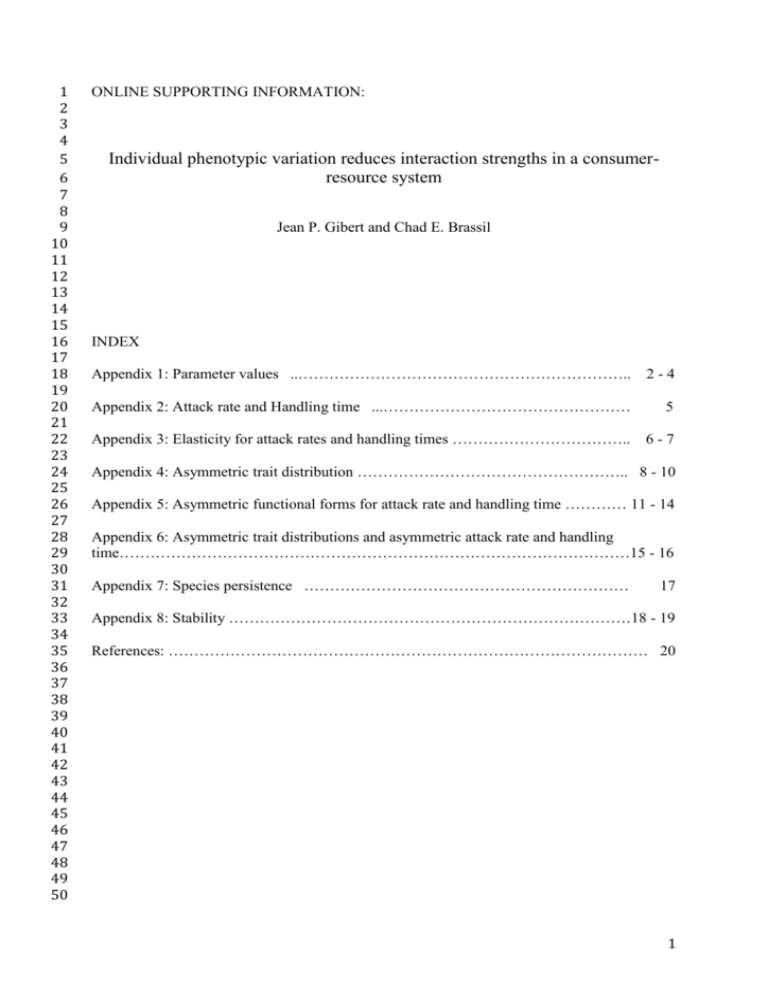
1 2 3 4 5 6 7 8 9 10 11 12 13 14 15 16 17 18 19 20 21 22 23 24 25 26 27 28 29 30 31 32 33 34 35 36 37 38 39 40 41 42 43 44 45 46 47 48 49 50 ONLINE SUPPORTING INFORMATION: Individual phenotypic variation reduces interaction strengths in a consumerresource system Jean P. Gibert and Chad E. Brassil INDEX Appendix 1: Parameter values ..……………………………………………………….. 2-4 Appendix 2: Attack rate and Handling time ...………………………………………… 5 Appendix 3: Elasticity for attack rates and handling times …………………………….. 6-7 Appendix 4: Asymmetric trait distribution …………………………………………….. 8 - 10 Appendix 5: Asymmetric functional forms for attack rate and handling time ………… 11 - 14 Appendix 6: Asymmetric trait distributions and asymmetric attack rate and handling time………………………………………………………………………………………15 - 16 Appendix 7: Species persistence ……………………………………………………… 17 Appendix 8: Stability ……………………………………………………………………18 - 19 References: ………………………………………………………………………………… 20 1 51 APPENDIX 1: Exploring different parameter values 52 In this section we assess how robust our results are to a change in parameter values. 53 We did so by exploring other possible values for da , dh , t and n . For changes in da and 54 dh our qualitative results hold, but an increase in dh seems to have a less pronounced effect 55 than one in da (Fig. S1-1; also see Appendix 3). As t and n increase, the effect of individual 56 variation decreases (Fig. S1-2). This occurs because the attack rate and the handling time 57 become constant, and largely independent of the value of the controlling trait. Small t or n 58 leads to a large dependency of the attack rate and the handling time upon the underlying trait 59 value, and hence, to an increased effect of individual trait variation (Fig. S1-3). 60 61 Fig S1-1: Plots of interaction strength against increasing individual variation (gray: resource, 62 black: consumer). (a) a = 1, hmax = 2, hmin = 1, t =3, n = 1, da = 2, dh = 0. (b) same as (a) but 63 for da = 0, dh = 2. 64 2 65 66 Figure S1-2: Plots of interaction strength against individual variation measured as s 2 . 67 Parameter values: (a) a = 1, hmax = 2, hmin = 1, t =3, n = 1, da = 0, dh = 0. (b) same as (a) but 68 for t =1, n = 3. (c) same as (a) but for t =3, n = 3. 3 69 70 Figure S1-3: Plots of interaction strength against individual variation measured as s 2 . 71 Parameter values: a = 1, hmax = 2, hmin = 1, t =0.1, n = 0.1, da = 0, dh = 0. 72 73 74 75 76 77 78 79 80 81 82 83 84 85 86 4 87 88 APPENDIX 2: Mean attack rate and mean handling time In what follows we show how the mean attack rate and the mean handling time change 89 with increasing levels of individual variation. While attack rate decreases with individual 90 variation whenever phenotypic mismatch is small, handling time increases (Fig. S2-1a). 91 When phenotypic mismatch is large, however, attack rate increases at first with variation and 92 then decreases, and the opposite is true for handling time (Fig. S2-1b). 93 94 95 Figure S2-1: Plots of how mean attack rate (black) and mean handling time (grey) change 96 with individual variation under small phenotypic mismatch (a) and larger phenotypic 97 mismatch (b). Parameter values: (a) a max = 2, hmax = 2, hmin = 1, e = 0.5, t =1, n = 1, 98 da = dh = 0 ; (b) same as in (a) but for da = dh = 2 . 5 99 100 APPENDIX 3: Elasticity The elasticity is a measure of model sensitivity defined as the absolute value of 101 ¶log( f ) ¶log(a) , where f is the function of interest (interaction strength in this case), and 102 a is the parameter of interest (attack rate or handling time in this case). The larger the 103 elasticity, the more sensitive the function is to a change in the parameter. 104 The effects of individual variation upon consumer-resource dynamics seem to be 105 mainly driven by variation in the attack rate, as its elasticity is generally larger than that of the 106 of handling time regardless of phenotypic mismatch or individual variation (Fig. S3-1). 107 Although Jensen’s inequality predicts opposite effects of variation in attack rate and handling 108 time when considered independently (Fig. 1a, 1b), interaction strengths incorporating 109 individual variation in both attack rate and handling time simultaneously seem to mainly be 110 affected by variation in attack rate. 111 112 113 114 115 116 117 118 119 120 121 6 122 123 Fig S3-1: Plot of the elasticity of the interaction strengths for with respect to the attack rate 124 (black) and the handling time (gray). (a) a = 1, hmax = 2, hmin = 1, t =1, n = 1, da = 0, dh = 0. 125 (b) same as (a) but for da = 2. (c) same as (a) but for dh = 2. 126 127 7 128 129 APPENDIX 4: asymmetric trait distribution In the main text we assumed the trait that controls the ecological interaction through 130 its effect on attack rate and handling time to be normally distributed. However, the 131 distribution of some traits is highly asymmetric and skewed (Gouws et al. 2011). In this 132 section, we break this assumption by incorporating an asymmetric distribution (log-normal 133 distribution, Fig. S4-1). We show that the effect of individual variation is not largely affected 134 by the choice of the underlying trait distribution but the range of scenarios at which 135 interaction strength decreases with individual variation becomes larger when asymmetry is 136 taken into account. 137 Here, we assumed both attack rate and handling time to depend on the value of a log- 138 normally distributed trait with location parameter x and scale parameter s 2 . Then its density 139 in the population is: é ( log(x) - x ) 2 ù ú. Lp(x, x ) = exp ê2s 2 êë úû x 2ps 2 1 140 (1) 141 Note that as both the location and scale parameter control the shape of the distribution, the 142 variance of the distribution, and hence, individual variation, now depends on both parameters. 143 For simplicity, we focus on the case where only s 2 varies. We have numerically integrated 144 I R,L (a, h ) and IC,L (a, h ) to find the interaction strength with varying levels of individual 145 variation s 2 as: 146 I R,L (a, h ) = -R ¥ a (x) ò 1+ a (x) h(x) R Lp(x, x ) dx (2) a (x) Lp(x, x ) dx 2 -¥ (1+ a (x) h (x) R) (3) -¥ 147 148 149 I C, L (a, h ) = e C ¥ ò We found that the interaction strength has a qualitatively similar behavior with respect to individual variation than in the case with a symmetric distribution. This is, there is a range 8 150 of scenarios at which the interaction strength decreases monotonically with individual 151 variation, and a range of scenarios at which the interaction strength is maximized by 152 intermediate values of individual variation (see main text). Indeed, there is an optimal amount 153 of individual variation that maximizes interaction strength when trait mismatch is large, if the 154 average trait value in the population is smaller than the selective optimum ( da << 0 or dh << 0 155 , Fig S4-2a), and this behavior is also quantitatively comparable to the one obtained with a 156 symmetric trait distribution. The interaction strength still decreases with individual variation 157 whenever trait mismatch is small ( da ~ 0 and dh ~ 0 , Fig S4-2b), but this is also true for 158 cases where the average trait value in the population is larger than the selective optimum ( 159 da >> 0 or dh >> 0 , Fig S4-2c). Thus, asymmetric trait distributions can increase the range of 160 scenarios in which interaction strengths decreases with individual variation. 161 162 163 Figure S4-1: Plot of a symmetric distribution (e.g. normal) and an asymmetric distribution 164 (e.g. log-normal). The log-normal distribution used in the supplementary material mainly 165 differs from the normal distribution used in the main text in that it the former is more skewed 166 than the latter. 9 167 168 Figure S4-2: Plots of interaction strength against individual variation measured as s 2 . 169 Phenotypic mismatch is large (a) and (c), and small in (b). Parameter values: (a) a = 1, hmax = 170 2, hmin = 1, t =1, n = 1, da = -2, dh = 0. (b) same as (a) but for da = 0. (c) same as (a) but for 171 da = 2. 10 172 173 APPENDIX 5: asymmetric functional forms for attack rate and handling time In the main text, we assumed the attack rate and handling time to be non-linear, yet 174 symmetric functional forms of the underlying controlling quantitative phenotypic trait. 175 However, these ecological attributes could be asymmetric, as found in most thermal response 176 curves (Vasseur et al. 2014). The asymmetry of these functional forms generally arise from 177 important physiological or biomechanical constrains (Vucic-Pestic et al. 2010), which need to 178 be taken into account to accurately describe the non-linear relationship between underlying 179 phenotypic traits and the ecological attributes they influence. In this section, we break the 180 assumption of symmetry for the attack rate and the handling time, by incorporating 181 asymmetric functional forms (Fig. S5-1). We found that the asymmetry in attack and handling 182 times can have a quantitative effect in the way individual variation affects interaction 183 strengths, mostly by reducing the range of possible scenarios in which interaction strength 184 decreases monotonically with increasing individual variation. 185 The now asymmetric predator’s attack rate, a asymm (x) , can be assumed to be maximal 186 at a given optimal trait value x = qa , and to decrease away from that maximum at a different 187 rate depending on the direction. Such a scenario can be modeled by: é ( log(x) - log(qa ) ) 2 ù ú, úû 188 a asymm (x) = a max - a max exp ê- 189 where a max is the maximal attack rate (Fig. S5-1a) and the rest of the parameters are as 190 described in the main text. Similarly, the predator’s handling time, hasymm (x) , is minimal at 191 the given optimal value x = qh , and increases away from that minimum at a different rate 192 depending on the direction like: 193 êë 2t 2 é log(x) - log(q ) 2 ù ( h ) ú , hasymm (x) = (hmax - hmin ) expê2 ê ú 2 n ë û (4) (5) 11 194 where hmax and hmin are maximal and minimal handling times respectively (Fig. S5-1b) and 195 the rest of the parameters are as described in the main text. Because of the asymmetry, it is 196 now impossible to derive analytic expressions for the mean (asymmetric) attack rate and 197 handling times, so we have numerically integrated I R, asymm (a, h ) and IC, asymm (a, h ) to find the 198 interaction strength with varying individual variation s 2 as: I R, asymm (a, h ) = -R 199 ¥ ò 1+ a -¥ I C, asymm (a, h ) = e C 200 ¥ ò -¥ 201 a asymm (x) p(x, x ) dx asymm (x) hasymm (x) R (1+ a a asymm (x) asymm (x) hasymm (x) R) 2 p(x, x ) dx (6) (7) Overall, we found that the asymmetry in attack rate and handling time seems to 202 preclude a monotonically decreasing relation of interaction strengths with individual 203 variation. If phenotypic mismatch is large enough and the average trait value in the population 204 is smaller than the selective optimum ( da << 0 or dh << 0 ), both the symmetric and the 205 asymmetric case predict a hump shaped relationship between interaction strengths and 206 individual variation. If phenotypic mismatch is small ( da ~ 0 and dh ~ 0 ), interaction seems 207 to only increase with individual variation when asymmetric attack and handling rates are 208 considered, rather than showing a monotonic decrease as with symmetric attack rates and 209 handling times (Fig. S5-2b). Finally, if the average trait value in the population is larger than 210 the selective optimum ( da >> 0 or dh >> 0 ), both the symmetric and the asymmetric case are 211 congruent. 212 213 12 214 215 Figure S5-1: Plots of attack and handling time against a given quantitative phenotypic trait, 216 where qa and qh are the optimal trait values for attack rate and handling time respectively. 217 Note that the ecological attributes are now asymmetric with respect to the trait of interest in 218 contrast to what was assumed in the main text (Fig. 2, main text). 219 220 221 222 223 224 225 226 13 227 228 Figure S5-2: Plots of interaction strength against individual variation measured as s 2 . 229 Phenotypic mismatch is large in (a) and (c), and small in (b). Parameter values: (a) a = 1, 230 hmax = 2, hmin = 1, t =1, n = 1, da = -3, dh = 0. (b) same as (a) but for da = 0. (c) same as (a) 231 but for da = 3. 14 232 233 APPENDIX 6: Asymmetric trait distributions, and asymmetric attack rate and handling time In this section, we incorporate asymmetric trait distributions as well as asymmetric 234 attack rate and handling times by means of equations (1), (4) and (5) of the supporting 235 information. Because of the asymmetry, it is now impossible to derive analytic expressions 236 for the (asymmetric) attack rate and handling time, so we have numerically integrated 237 I R, Lasymm (a, h ) and IC, Lasymm (a, h ) to find the interaction strength with varying individual 238 variation s 2 as: 239 I R, Lasymm (a, h ) = -R ¥ ò 1+ a -¥ 240 I C, Lasymm (a, h ) = e C ¥ ò a asymm (x) Lp(x, x) dx asymm (x) hasymm (x) R a asymm (x) -¥ (1+ a asymm (x) hasymm (x) R ) 2 Lp(x, x ) dx (8) (9) 241 The results for asymmetric distribution and asymmetric attack rate and handling time 242 are comparable to those found in Appendix S5. Specifically, whenever phenotypic mismatch 243 is large enough and the average trait value in the population is smaller than the selective 244 optimum ( da << 0 or dh << 0 ), the symmetric and the asymmetric cases yield comparable 245 predictions (Fig. S6-1a). Conversely, the interaction strength seems to be maximized by 246 intermediate levels of individual variation whenever phenotypic mismatch is small ( da ~ 0 247 and dh ~ 0 ), but this differs from what is predicted by the symmetric case (Fig. S6-1b). 248 Finally, whenever the average trait value in the population is larger than the selective 249 optimum ( da >> 0 or dh >> 0 , Fig. S6-1c), both symmetric and asymmetric cases are 250 congruent. Overall, it seems that asymmetric relationships between the attack rate and the 251 handling time with the underlying controlling quantitative trait precludes interaction strengths 252 to decrease with individual variation, but the opposite is truth whenever only asymmetric 253 distributions are considered. 15 254 255 Figure S6-1: Plots of interaction strength against individual variation measured as s 2 . 256 Phenotypic mismatch is large in (a) and (c), and small in (b). Parameter values: (a) a = 1, 257 hmax = 2, hmin = 1, t =1, n = 1, da = -2, dh = 0. (b) same as (a) but for da = 0. (c) same as (a) 258 but for da = 5. 16 259 260 261 APPENDIX S7: Consumer persistence Large values of individual variation can lead to consumer extinction (Fig S7-1), as suggested by eqn 14 and eqn 15 of the main text. 262 263 264 265 266 Figure S7-1: Outcome of the consumer-resource interaction as a function of individual 267 variation ( s 2 ) and phenotypic mismatch between preys and predators ( d 2 ). In the black 268 region, consumers go extinct but the resource survives, while in white and grey regions both 269 consumers and resources coexist. Parameter values: a max = 2, hmax = 2, hmin = 1, e = 0.5, t =1, 270 n = 1, da = dh , K=1, b = 0.1. 271 272 17 273 APPENDIX S8: Here we show that for those values of s 2 for which coexistence is ensured, the larger 274 275 s 2 is, the more stable the system becomes. To do so, we observe that, if s 2 is very small, 276 then the following equality holds, ¥ a (x ) R RC a (x) =ò p(x, x ) dx , 1+ a (x ) h (x ) R -¥ 1+ a (x) h(x) R 277 278 (10) where: ¥ a (x ) = ò a (x)p(x, x ) dx 279 -¥ é ù a max t da2 , exp ê2 2 ú ë 2 (s + t ) û s 2 +t 2 = 280 (11) ¥ h (x ) = ò h(x)p(x, x ) dx 281 -¥ = hmax - 282 n (hmax - hmin ) s 2 +n 2 é ù dh2 exp êú, 2 2 ë 2 (s + n ) û (12) 283 and da = x - qa and dh = x - qh , are the distance between the mean trait in the population and 284 the adaptive optimum (phenotypic mismatch). 285 Hence, assuming that individual variation is small enough, we can assess local 286 stability of the dynamic system by replacing the functional response defined in the main text 287 (in eqn 13 of the main text, or right side of eq. 10 in appendix) by the functional response 288 evaluated at a (x ) and h (x ) , and by then calculating the Jacobian of the system at its 289 equilibrium: 290 æ ö é ù ç - r d ëe - Kea (x )h (x ) + d h (x ) (1+ K a (x )h (x ))û - d ÷ ç K a (x )h (x )e (e - d h (x )) e ÷ ÷. J R*,C* = ç æ d ö ç ÷ rç + e - d h (x )÷ 0 ÷ çç ÷ è K a (x ) ø è ø (13) 18 291 The system is stable, if and only if the determinant of J R*,C* is positive but its trace is 292 negative. The latter is true whenever: 293 d< e + d h (x ) e and a (x) < . We can now use (11) of the appendix to obtain: K h (x) (e + d h (x )) h (x ) 294 é ù amax t da2 e + d h (x ) . exp ê< ú 2 2 ë 2 (s + t ) û K h (x ) (e + d h (x )) s 2 +t 2 295 If phenotypic mismatch is small ( da2 ~ 0 ), we can rearrange the eq. 14 to obtain: 296 s2 > a max t K h (x ) (e - d h (x )) 2 -t . e + d h (x ) 297 Finally, if we further assume that variation in attack rate has a larger effect than that in 298 handling time, as observed in appendix 3, we get eq. 3.3 of the main text: 299 s2 > amax t K hmax (e - d hmax ) 2 -t . e + d hmax (14) (15) (16) 300 Eq. 16 implies that for the system to be stable, individual variation needs to be larger than a 301 certain amount. This is supported by our simulations (Fig 3, main text), as increasing 302 variation forces the system through a Hopf bifurcation, from an attractive limit cycle to an 303 attractor node. Although the limit cycle is orbitally stable, the population fluctuations 304 underwent by both interacting species makes the system more likely to lose species due to 305 demographic or environmental variability. 306 307 308 309 310 311 312 19 313 314 315 REFERENCES: 316 Gouws EJ, Gaston KJ, Chown SL. 2011 Intraspecific body size frequency distributions of 317 318 319 insects. PloS ONE, 6, e16606. Schreiber SJ, Bürger R, Bolnick DI. 2011 The community effects of phenotypic and genetic variation within a predator population. Ecology, 92, 1582–93. 320 Vasseur DA, Delong JP, Gilbert B, Greig HS, Harley CDG, McCann KS, Savage V, Tunney 321 TD, O’Connor MI. 2014 Increased temperature variation poses a greater risk to species 322 than climate warming Increased temperature variation poses a greater risk to species 323 than climate warming. Proc. R. Soc. B Biol. Sci. 281. 324 325 Vucic-Pestic O, Rall BC, Kalinkat G, Brose U. 2010 Allometric functional response model: body masses constrain interaction strengths. J. of Anim. Ecol., 79, 249–56. 326 20

